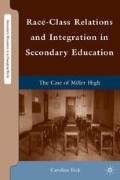Abstract
Miller High students, as earlier suggested, associated mostly on the basis of common interests and affinities within interracial, cross-track, and sometimes even cross-gender peer-generated groups. Describing the cafeteria, Tim Whittle recalled that “male jocks [black and white] had a table, girl jocks [black and white] had a table, the eggheads [black and white] had a table…,” and so on. Overwhelmingly, graduates remembered blacks and whites getting along within and across the peer groups.1 African American Joanne Pet’s recollection captured the civil rights mood of the time:
Given that it was five or six years after Martin Luther King and the civil rights [movement], I was right there on the crest of it. So I didn’t feel the effect of racism… I don’t remember any incident that I felt that I was discriminated against because I was black…My friends, basically, they were all white.
Access this chapter
Tax calculation will be finalised at checkout
Purchases are for personal use only
Preview
Unable to display preview. Download preview PDF.
Notes
See the work of Philip Cusick, Inside High School: The Student’s World (NY: Holt, Rinehart, and Winston, 1973). Cusick argues that the small friendship groups of youth are reactions to the disempowering effects of secondary schools, which herd youth and devoid them of autonomy.
See Stephanie Coontz, The Way We Never Were: American Families and the Nostalgia Trap (NY: Basic Books, 2000), xi.
See Arthur G. Powell and Eleanor Farrar, The Shopping Mall High School (Boston: Houghton Mifflin, 1985), as well as Labaree’s work earlier cited.
For works that examine black high school youth political engagement, see Dwayne C. Wright, “Black Pride Day, 1968: High School Student Activism in York, Pennsylvania,” Journal of African American History 88 (2003): 151–162.
Dionne Danns, “Chicago High School Students’ Movement for Quality Education, 1966–1971,” Journal of African American History 88 (2003): 138–150.
See also V.P. Franklin, “Black High School Student Activism in the 1960s: An Urban Phenomenon?” Journal of Research in Education 10 (Fall 2000): 3–8.
Copyright information
© 2010 Caroline Eick
About this chapter
Cite this chapter
Eick, C. (2010). Bridging Social Divides Through Peer-Groups: A Socially Tolerant but Politically Inactive Student Body (1970–1985). In: Race-Class Relations and Integration in Secondary Education. Secondary Education in a Changing World. Palgrave Macmillan, New York. https://doi.org/10.1057/9780230114425_5
Download citation
DOI: https://doi.org/10.1057/9780230114425_5
Publisher Name: Palgrave Macmillan, New York
Print ISBN: 978-1-349-29059-8
Online ISBN: 978-0-230-11442-5
eBook Packages: Palgrave Education CollectionEducation (R0)

